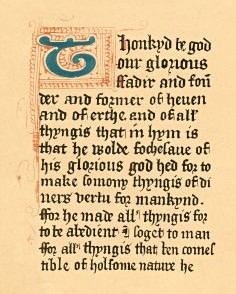Get Today in Masonic History into your Inbox. Sign up today for one of our email lists!
Need an article for your Trestleboard/Newsletter see our Use Policy
The Cooke Manuscript

Today in Masonic History we present The Cooke Manuscript.
The Cooke Manuscript is the second oldest document known about Freemasonry.
The Cooke Manuscript was first translated and published in the 1800's by R. Spencer and edited by Mr. Mathew Cooke, who gave his name to the manuscript.
Similar to the Regius poem, the Cooke Manuscript starts in antiquity and describes the events leading to the development of Freemasonry. It starts with describing the seven liberal arts and directly equating geometry with masonry. Unlike the Regius poem, the Cooke Manuscript describes the tale of the children of Lamech who was a descendant of Cain in the Book of Genesis. One of Lamech's children is Jabal who discovers geometry. Among Lamech's other children are Jubal who discovers music, Tubal Cain who discovers metallurgy and the art of the smith, Naameh, daughter of Lamech, who invents weaving. When the children of Lamech learn the world is going to be destroyed either by fire or flood they inscribe their knowledge on two pillars, one of stone and one of wood. The first capable of surviving fire (conflagration) and the other having the ability to float (inundation). These pillars are later discovered by Pythagoras and the other by the philosopher Hermes. The knowledge was then passed down through Nimrod who created the Tower of Babel.
It is here the Cooke Manuscript comes back together with the Regius Manuscript, although not completely, with the details of the story. In the Cooke Manuscript the knowledge is passed to the Egyptians and to Euclid and eventually to the court of Athelstan in England where the same nine articles, rules for the job site, and nine points, rules for the Freemason, are put down.
Unlike the other ancient masonic documents, the charges and constitutions are not put down on a scroll or rolls. Instead the Cooke Manuscript is written on pieces of vellum and then placed in a book which is covered by two pieces of oak.
James Anderson of Anderson's Constitutions, written in 1723, had access to the Cooke Manuscript when he wrote his constitutions. In a footnote at the end of Anderson's Constitutions he quotes the last 60 lines of the Cooke Manuscript describing the assembly in York in the court of Athelstan.
The Cooke Manuscript is dated at 1450. Early attempts to date the manuscript had it at 1482, although it was dated this way due to a translation error by Cooke. It is believed due to some obvious transcription errors in the document, it was copied from another manuscript. It is believed the original manuscript was a contemporary document of the Cooke Manuscript and unlikely a work from earlier as Freemasons were banned from meeting together for fear they might demand higher wages.
On line 603 of the Manuscript the line is found: For of specculatyfe he was a master and he lovyd well masonry and masons. And he bicome a mason hym selfe. It is believed this is reference to the King's son having joined Freemasonry as a speculative mason.
This article provided by Brother Eric C. Steele.

